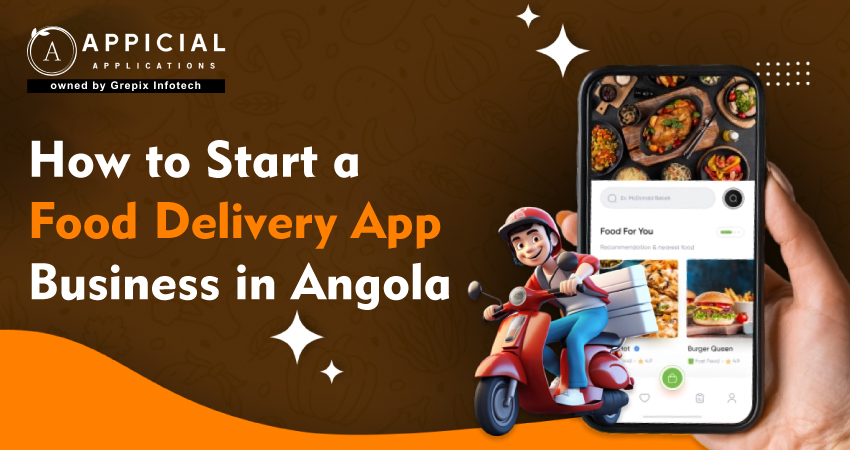
How to Start a Food Delivery App Business in Angola
Angola is changing fast. Its cities are expanding. Young people are going digital. And expectations keep rising.
People now expect to order food from home. They expect speed, variety, and reliability. They don’t want to wait.
Yet logistics remain behind. Few delivery apps serve the market. Restaurants manage orders over the phone or SMS. Many lack real-time tracking. Some deliveries never arrive.
That leaves a big opportunity. A reliable, local food delivery app can fill the gap. It can connect restaurants with hungry customers. It can offer live tracking and payment options that make sense in Angola.
If executed properly, this is more than a service; it’s a trusted brand. And in 2025, the timing is right.
Angola’s online food delivery market is growing fast. With a robust compound annual growth rate of more than 15% through 2030, revenue is expected to reach approximately US$212 million in 2025. About 45% of people are online despite the low level of internet access, and urban areas are growing rapidly. Customers are requesting more food delivery app options, and local businesses require improved logistics assistance. In this blog, we walk you through why now is the right time to build food ordering apps in Angola. You’ll learn about must-have features, tech stack, development costs, challenges, and how Appicial Applications can help bring your idea to life.
Why Invest in Food Delivery App Development in Angola?
Angola is changing, and fast. The digital economy is picking up pace. With more people living in cities, more smartphones in hand, and growing demand for convenience, now is the time to build a food delivery app in Angola.
- Fast-rising market size: With significant growth anticipated, the market is projected to bring in about US$212.74 million in 2025.
- Underpenetrated but promising: Mostly in urban areas, only 44–45% of people use the internet. As connectivity increases, that creates space for expansion.
- Urbanization fueling demand: Cities like Luanda host a growing middle class that values convenience. Millennials and Gen Z favor digital food options.
- Few strong competitors: While companies like BayQi, Tupuca, Mamboo, and Kumoxi operate locally, they don’t yet dominate. That means there’s room for a well-designed, efficient, and trusted food delivery app that puts the user first. Get in early, and you could become that go-to brand.
- Mobile-based economy: A majority access the internet via mobile phones. E-commerce, including food ordering, happens on apps. A digital-first platform fits perfectly. Your platform is already ahead of the curve if it is mobile-friendly.
- Government Support for Digital Growth: The Angolan government is aggressively promoting the expansion of digital infrastructure and digital entrepreneurship. This includes tax breaks for tech startups, digital education, and the growth of mobile internet.
- Opportunity for Multi-Service Expansion: Start with food, then scale. Once your app gains traction, you can branch out into groceries, medicine, or even home services. Think of the UrbanClap Clone App model. Many delivery platforms start small, then expand their ecosystem. That could be your long-term strategy, too.
- Untapped Niche Opportunities: Street food vendors, home-cooked meals, vegan cuisine, and even traditional Angolan dishes are examples of underserved food niches. Smaller markets that are ignored by the major players can be dominated by a specialized food delivery app that caters to these categories.
In short, this is a ripe moment to build a scalable food delivery app.
What are the Must-Have Features for a Food Delivery App?
Your app should feel intuitive to both customers and restaurants. Here are the essentials:
Customer App:
- Attractive onboarding phone or email sign-up
- Menu browsing, filters, dish descriptions
- Real-time DoorDash food delivery-style tracking
- Estimated arrival times
- Push notifications or SMS updates
- Secure payments local debit cards (Multicaixa), mobile wallets
- Ratings and reviews
- Offers or promos
Restaurant Partner App:
- Accept or reject orders
- Live order queue
- Cooking time input
- Dashboard with sales and metrics
- Notifications on new orders
Driver or Courier App:
- Accept delivery tasks
- Navigation optimized route maps
- Status updates assigned → picked up → delivered
- Earnings tracker and history
Admin Dashboard:
- Real-time monitoring of app activity
- User, restaurant, and driver management
- Order analytics and busiest hours
- Promo code tools
- Support interface for customer issues
These features align with the global DoorDash delivery app and Grubhub delivery experiences, but are tailored to Angola’s context.
What is the Technology Stack and Architecture?
Choosing the right tech stack ensures performance and scalability:
Frontend (Apps and Web):
- Use Flutter or React Native for Android and iOS apps. Web dashboard via React.js or Angular.
Backend:
- Node.js or Python with frameworks like Express or Django. Database: PostgreSQL or MongoDB. Caching via Redis.
Third-party services:
- Google Maps API for navigation
- Twilio or Firebase for notifications
- Payment gateway integration local systems like Multicaixa or mobile wallet APIs like BayQi.
Hosting:
- AWS, DigitalOcean, or local providers with good latency in Luanda.
Modular architecture:
- Separate modules for customers, restaurants, drivers, and admin logic. This enables easy updates and feature scaling.
This setup supports fast communication, real-time order flow, and secure payment processing.
What are the Challenges and Market Gaps in Angola?
Understanding Angola's constraints and user expectations is essential to launching a successful food delivery app:
- Limited internet penetration: Rural areas continue to be underserved, despite an increase in urban access. Even on slower networks, the application must run without a hitch.
- Infrastructure issues: Road conditions and traffic in cities like Luanda can delay deliveries. The app should include flexible ETA and alternate routing.
- Payment constraints: Credit card usage is rare. Most payments are via cash or domestic debit card (Multicaixa). Integration with local wallets like BayQi is essential.
- Trust and reliability: Customers want to know that their food will arrive promptly, hot, and fresh. Confidence is increased by clear service fees and visible tracking.
- Restaurant adoption: Many local eateries lack digital experience. Onboarding and training must be included.
- Operational support: Support channels (chat, call) are vital. Delivery failures or food quality issues can damage reputation fast.
If you address these gaps with thoughtful design and local adaptation, you’ll stand out.
Also Read: How to Start a Food Delivery App Business in Uganda?
Estimated Development Cost & Timeline
Building a quality food ordering app in Angola typically follows two phases:
Basic MVP Phase
- Customer, driver, and restaurant apps + basic admin
- Core tracking, menu display, payment integration
- Development time: 3–4 months
- Estimated cost: $20,000–$35,000 USD
Advanced Platform Phase
- Loyalty systems, in-app marketing, analytics, multi-language support
- Enhanced routing, dynamic pricing, support tools
- Development time: 6–9 months
- Estimated cost: $40,000–$70,000+ USD
Ongoing costs: hosting, maintenance, feature updates, user support. Start lean. Add advanced features progressively.
How Appicial Applications Can Help?
At Appicial Applications, we’ve built successful food delivery app development systems for emerging markets with local payment, language, and logistics considerations built in.
Here’s what we provide:
- Pre-built app templates that work like international platforms (think Grubhub delivery or DoorDash food delivery) but localized for Angola
- Custom integrations with Multicaixa, BayQi, or local wallets.
- Lightweight and optimized UI, designed to work on mobile data and basic Android phones
- Onboarding support for restaurants and couriers
- Marketing & growth strategies tailored to local word-of-mouth and referral culture
- Post-launch services from updates to customer support tools
We’re more than a vendor. We’re your partner to help you launch smart, scale effectively, and maintain user trust.
Conclusion
Angola’s food delivery ecosystem is ready for transformation. Rising internet access in urban areas, growing demand for convenience, and a gap in strong delivery platforms set the stage.
A well-designed food delivery app offers restaurants a lifeline. Customers get the convenience they expect. And you get a scalable, meaningful business.
Focus on real local needs: reliable payments, lighter app experience, transparent tracking, and strong support. Build the basics first. Grow smartly. Partner with a team that knows both global standards and local realities.
With the right features, strategy, and execution, your platform could emerge as Angola's go-to food delivery app. Let's work together to make it happen with Appicial Applications.
FAQs
Author's Bio

Vinay Jain is the Founder at Grepix Infotech and brings over 12 years of entrepreneurial experience. His focus revolves around software & business development and customer satisfaction.
Back to blog list




